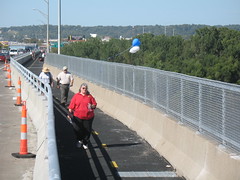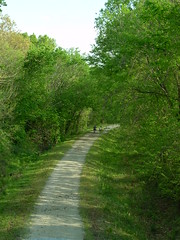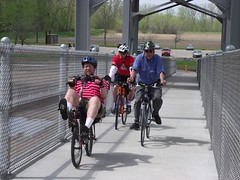AP Fact Check: Stories disparaging Transportation Enhancements funding are exaggerated or misleading
Next week a small group of U.S. senators is forcing a vote on a proposal to eliminate the Transportation Enhancements and other bicycle/pedestrian funding in the federal transportation budget.
An AP story fact-checking the stories members of Congress are telling about Transportation Enhancements is in the Kansas City Star and newspapers around the state and U.S. today.

The fact check is unusual--every supposedly horrible example of Transportation Enhancements spending is completely debunked.
Each example turns out to be either grossly exaggerated or completely misleading.
That's not surprising, because Transportation Enhancements is the single largest source of funding for bicycle and pedestrian funding in the U.S. today, and those projects are important, popular, and much needed.
There are more than enough very good, very needed, projects to crowd out bad projects--and it looks like that is exactly what happened to many of the examples opponents have cited. They were bad and so they were turned down for funding entirely.
That's a sign of a system that is working--but it hasn't stopped opponents from clogging the media airwaves and the public discourse with these fabricated examples.
Transportation Enhancements has started to turn the tide in America
Since 1991, Enhancements funding has helped turn the tide in America, from a country that had completely neglected bicycle and pedestrian needs for decades, to one that puts bicycle and pedestrian spending on the nation's priority list--even if bike/ped funding is not as high as it could or should be.
Enhancements funding is used effectively and fills an important need in communities large and small, and ranging from urban to suburban to rural.
Bicycle and pedestrian projects are inexpensive, cost-effective, popular with citizens, and well used.
We always have plenty of money to build a new freeway through town or add an extra lane so that semi-trucks can get there a few minutes faster. And you're telling us we can't put in a sidewalk and a crosswalk on the state highway going through town, so that grandma can get from her home to the grocery store safely?
Exaggerated and misleading claims
From the Kansas City Star:
It's an outrageous tale: The federal government spends one out of every $10 in transportation aid on wasteful projects such as refurbishing a giant roadside coffee pot and constructing turtle tunnels.
That's what Republican lawmakers have said repeatedly in recent weeks in the Senate, in public appearances and in news releases. They are trying to eliminate a requirement that states use a portion of their highway aid for "transportation enhancements," 12 categories of projects from bike and walking paths to scenic overlooks and landscaping.
But it's not exactly true.
To make their case, lawmakers have exaggerated and misrepresented some projects that have received aid.
Coburn picked his examples from the more than 25,000 projects that have received money since Congress established the enhancement set-aside nearly two decades ago. . . .
Read the complete article for details, but here are the conclusions--every single example cited is terribly exaggerated, misleading, or just plain wrong:
- "We did not use any of this $300,000 award for anything to do with the coffee pot," she said. "It's interesting that nobody from Senator Coburn's office called me about this." . . .
- Actually, no transportation dollars have been authorized or awarded. The lighthouse renovation is among projects community officials tentatively hope to get around to in 2019. . . .
- Not mentioned is that the grant wouldn't qualify for enhancement money under current program rules, according to Transportation Department officials. . . .
Transportation Enhancements across the Missouri River at Jefferson City- [T]hey weren't federal transportation dollars. U.S. transportation officials said an application for the money was turned down. . . .
- [F]ederal officials said the project was canceled years ago and again, no funds were awarded. . . .
- The simulator theater is really a driver-education classroom for free driving classes for older people and teenagers, not a chance to pretend to be behind the wheel of a Corvette, museum officials said. . . .
- While turtle deaths prompted the project, the culverts are being used by many other species, including beavers, otters, alligators and snakes. They make driving safer for motorists who were swerving to avoid turtles and alligators, said Matt Aresco, the former Florida State University Ph.D. student who led a grassroots campaign for the project.
"It's a significant safety issue," he said. . . .- [Opponents] also have said repeatedly that states are required to spend 10 percent of their transportation aid on enhancements. Actually, the set-aside for enhancements is equal to 10 percent of the aid states receive through one transportation program, not their total federal aid. Enhancement funds amounted to $927 million in the past year, 2 percent of the $46 billion the government spent on highway programs.
If these are the worst examples they could find out of 25,000 projects in the past 20 years, it sounds like a very good program indeed.
Like many federal programs of this type, Transportation Enhancements puts decision-making power in the hands of local communities, subject to rules and oversight from the U.S. Department of Transportation.

Opponents don't like to mention the real core of Transportation Enhancements projects, the bread and butter of the Transportation Enhancements program.
That's because these projects are vitally needed and very popular with constituents from every side of the political aisle.
For example, Transportation Enhancements in Missouri has provided partial funding and support for projects in Missouri that have:
- Filled in sidewalk gaps along major streets (that also just happen to be state or federal highways) in cities and towns
- Created safe bicycle and pedestrian crossing points of rivers, freeways, railroads, and other major barriers
- Built major connecting pieces that have served as the anchor and starting point of trails system in cities across Missouri
 Katy Trail--one of Missouri's first and most successful Transportation Enhancements projects
Katy Trail--one of Missouri's first and most successful Transportation Enhancements projects - Funded the initial stages of citywide bicycle plans
- Built the Katy Trail
- Created bicycle and pedestrian access along or parallel to major highways and streets that were originally built without highway access
If you want to see bicycling and walking become mainstream in the U.S. again, preserving Transportation Enhancements--and, in general, preserving a fair share of federal funding for bicycling and walking--should be at the top of your priority list.
We've tried the alternative, and it ain't pretty . . .
Next steps
- Advocacy Alerts
- News
- Tour of Missouri
- 2011
- about
- adt
- Advocacy Alert
- advocacy101
- america
- award
- bicycle
- bicycling
- Bike
- budget
- campaign
- cities
- city
- community
- congress
- cost
- crosswalk
- education
- federal funding
- federal transportation
- first
- form
- funding
- grant
- illinois
- issues
- jefferson city
- kansas
- kansas city
- kansascity
- katy trail
- links
- media
- members
- missouri
- missouri bicycle federation
- missouri river
- Missouri Tourism
- mobikefed
- pedestrian
- points
- rules
- rural
- safety
- senate
- sidewalk
- St-Louis
- story
- streets
- trail
- trails
- transportation
- transportation enhancements
- truck
- trucks
- urban
- used
- vacation
- vote
- walking
- worst
- Business
- Coburn
- Congress
- Entertainment
- Florida
- Florida State University
- Freeway
- Kansas City
- Kansas City Star
- Matt Aresco
- Missouri
- Motion
- Pedestrian
- Road transport
- Senate
- the Kansas City Star
- The lighthouse
- Tourism
- Transport
- transportation
- Travel
- United States Department of Transportation
- Walking
Join MoBikeFed's Advocacy Network
Working together we make a real difference! Join our advocacy network:
Related pages
Current topics...
Archives...
Want better bicycling and walking in Missouri?
We rely on the support of members like you. Please join, renew, or donate today.
- Home
- JOIN/DONATE
- News/Info
- Missouri Bicycling, Running, Trails
- Bicycle Skills and Safety
- Missouri Bike/Ped Law
- Clubs and Organizations
- Bike Shops
- Running Shops
- Bicycling, Running, Trails-related Businesses
- Ride, Run, Walk, Hike, Triathlon, and Events Calendars
- Bicycles on Amtrak
- Maps and Routes
- Trails and Trail Maps
- IBikeMO.org
- Planning a Missouri bicycle trip
- Gravel and Bikepacking Maps & Routes
- Bicycle & Touring Routes
- Advocacy
- Campaigns
- Our Legislative Platform
- Complete Streets
- Statewide Rock Island Trail
- Statewide Trail Vision - Quad State Trail
- Bicycle Friendly Missouri
- Walk Friendly Missouri
- Safe Routes to School
- MoDOT funding crisis
- High Priority Bike/Ped Project List
- Anti-harassment laws in cities & statewide
- Updating the basic bicycle law
- Our Vision for MoDOT
- Our Vision for MPOs/RPCs
- Our Vision for Cities & Counties
- Bicycle, pedestrian, trails plans across MO
- Protecting Vulnerable Road Users
- Vision Zero
- Missouri Trail Towns
- Store
- About


